Scott Berkun's Blog, page 82
October 7, 2010
The wonder of assembly lines (My day at Ford)
On my recent trip to Detroit, I saw many interesting things. I saw Jeff Gurney sing at the Red Ox Tavern in Utica (Not bad for a Tuesday). I stayed at the ritzy MGM Grand Detroit, a short walk from the emptiest downtown streets I've seen this year (Greektown and the Fox theater were fun though). I spoke at the surprisingly cool Lorenzo Cultural Center, as part of their month on American Ingenuity, where everyone is smart and friendly.
But the hands down highlight of the trip was my afternoon at the Ford Rouge factory tour.
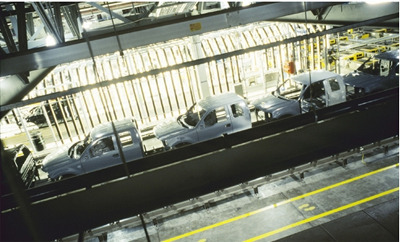
Most factory tours aren't tours. They're PR fabrications. For years I'd stop at the Hershey factory 'tour', on my regular end of semester trip between CMU and NYC. It was cute and silly, with bad animatronics and cheezy movies about how cocoa beans eventually become hershey's kisses. Not much of a tour, but a fun break on a long trip.
The Rouge factory tour (Rouge is the name of the nearby river) is the real deal. After a few short PR-ish films (kudos for a mention of Ford's early union battles), you walk on an observation catwalk above the Ford F-150 assembly line – it's the real thing. And it's self guided. No photography is allowed, and cell phones are prohibited, but I spent an easy hour watching in fascination as people and machines worked in tandem to build cars.
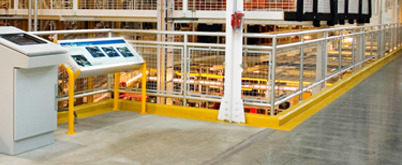
The observation area is a catwalk above the factory floor, and you can walk around the entire perimeter. Kiosks tell you about each of the major areas you can look down to see and how each section works.
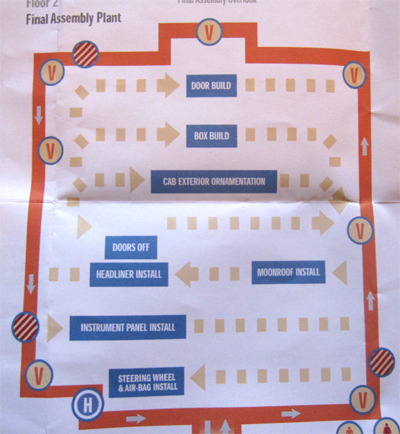
Workers stand on moving skids, traveling with each car until their tasks are done. Then they step off, and move back up to the next car. The line moved perhaps a foot or two every second. Not that fast to my nieve eyes, but given the number of tasks each worker had to perform, it was impressive none the less. And the longer I watched the more impressive this pace seemed.
Most fascinating was the design of the line itself. Hundreds of details must be sorted for each car, and communicated to dozens of workers. Huge scoreboards showed the line status, but other terminals and indicators helped each section discover and track what needed to be done for each car. Designing a system like this involves a huge set of skills: interaction design, workflow, process, economics… the amount of thinking that goes into a line like this is hard to fathom. And the work involved by each person on the line, despite the automation and technology, was intricate, careful and precise. In just a few minutes of watching anyone on the line, I was reminded of how much effort goes in to make a single car, much less 1000 or so a day. It really did make me want to go buy a Ford F-150.
All these thoughts are, I'm sure, well beyond the dreams Ford had when he considered that how butchers work with meat in automated lines, might just be useful for assembling cars.
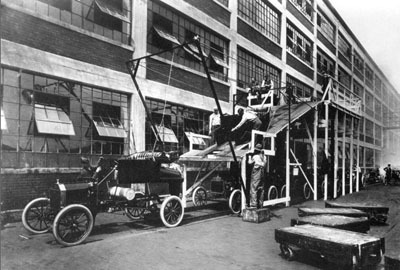
If ever you're in the area, I highly recommend the tour. It was the most interesting hour I have spent watching things indoors in some time. Somehow watching software and new technology being made can never approximate the wonders of the construction of physical things.
Contest: The secret for spreading ideas? (prize: signed copy)
As part of the countdown to Myths of Innovation day (Oct 13th - sign-up here), we're running trivia and other contests, with some fun and unusual prizes. Some questions require looking at the free sample chapters found here (PDF).
The Prize: A signed copy of the new paperback edition of Myths of Innovation.
Rules: anyone enters by leaving a comment – one winner will be chosen at random from correct entries. I'm the final arbiter of rules, including rulings about rules or rule like sub-rules, slide-rules, slides of all kinds, laws, by-laws, in-laws, laws about common law rules regarding the application of contest laws and sub-law rulings.
Ready? Here we go:
Some have complained the questions are to easy. Ok – try this one.
Question: Which of Rogers factors in Innovation diffusion is the hardest for an inventor to overcome? and why? (see chp 4 in the free sample)?
Trivia winners so far are…
For the first two days of trivia, the winners are:
Day 1 – What is the definition of ideas from chapter 12:
Winner for most original answer: Piet van Oostrum #
Winner for first correct answer: Eric #
Day 2 – Define the Innovators dilemma in own words:
Winner: Brian Yambe – "Getting better and better and solving a problem fewer people care about" #
Runner up, Michael: "No one understands me!"
Brian's answer isn't what Clayton Christensen, or myself said, but i asked for in your own words and Brian delivered.
I have sent all the winners email – if you didn't get it, let me know.
Today's question will be posted within the hour.
Free Myths Webcast: Wed Oct 13th
As part of Myths of Innovation day, I'll be doing a free, live webcast on all things innovation, Wed Oct 13th 2010, at 10am PST.
I'll be talking about new material – using stuff from previous talks as little as possible. So we're calling it Remixed and Remastered.
In fact: You can help with this goal – I want to work in as many questions as I can from you.
Have an issue something related to ideas, invention, innovation foo you want me to answer? Even a tough, tricky, uber-hard question or situation? Fire away. If I use your question, you'll get a free copy of the book.
When: Wed, October 13, 2010 10am PT
Where: wherever you are
What: best free webcast on innovation ever (ok, at least this week)
October 5, 2010
Myths trivia #2: signed copy + $25 amazon giftcard
As part of the countdown to Myths of Innovation day (Oct 13th - sign-up here, or on facebook), we're running trivia and other contests, with some fun and unusual prizes. Some questions require looking at the free sample chapters found here (PDF).
The Prize: A signed copy of the new paperback edition of Myths of Innovation.
Rules: anyone can enter by leaving a comment – one winner will be chosen at random from correct entries. I am the final arbiter of all rules, including rulings about rules or rule like sub-rules, laws, by-laws, in-laws, laws about common law rules regarding the application of contest laws and sub-law rulings.
Ready? Here we go:
Question: In your own words, describe the innovators dilemma? (Most entertaining answer wins)
October 4, 2010
Myths Trivia Contest: Win signed copy + prizes
As part of the countdown to Myths of Innovation day (Oct 13th - sign-up here), we're running trivia and other contests, with some fun and unusual prizes. Some questions require looking at the free sample chapters found here (PDF).
The Prize: A signed copy of the new paperback edition of Myths of Innovation.
Rules: anyone can enter by leaving a comment – one winner will be chosen at random from correct entries. I am the final arbiter of all rules, including rulings about rules or rule like sub-rules, laws, by-laws, in-laws, laws about common law rules regarding the application of contest laws and sub-law rulings.
Ready? Here we go:
Question: What is the definition of an idea offered in Chapter 12 (see chp 12 in the free sample)?
Myths of Innovation Trivia: Get it right, win a signed copy, plus a $25 amazon.com gift certificate.
September 28, 2010
The make vs. consume ratio
Years ago I realized the pleasure of spending a few bucks to see something that cost $100 million or more to make. It's a special bargain when you realize dozens or hundreds of people spent years making something you can watch in just over an hour. A novel which takes a few hours to read, might have taken years or a lifetime to write, and that compression of effort, when you stop to think about it, adds meaning to all created things. Even if ordinarily, you might not like result of that work.
As a maker (e.g. writer) I've learned there's an available mindset when I'm watching, reading or using something, where I'm thinking not only as a consumer but also as creator. Why did they design it this way? What were they thinking here? How many meetings did it take to decide that shot? Or that plot twist? What were they trying to do, and how do I imagine they considered the result? Even for a bad film, this framing can make the experience quite different and often much better. Even for a bad experience, given the amount of effort that went into it, I can find it interesting or educational for reasons other than the consumer experience alone.
Matt Mullenweg (who is currently my boss), wrote this a few months ago:
I wonder if there could be some sort of metric for writing that told you the ratio of time-to-create versus time-to-consume. On Twitter it's basically 1:1, you can craft and consume a tweet in a time measured in seconds. For this blog post, it may take me an hour to write it and 5 minutes to read (not skim) it. You can work your way all the way up through 8-10,000 word essays, and books that may take years and years (or a lifetime) to create.
I've thought about this in various forms over the years. Sometimes it's hard to guess at the true ratio: I do know writers who agonize over tweets, in the same way poets suffered offer their short poems. Some great works were easy to do (if you don't include the time required to learn the trade), and some awful works took years of hard work.
Regarding the ratio: It seems the greatest relationship is likely in old cathedrals, which took hundreds of people dozens of years to make. Films, in terms of expense, are hard to beat: years of effort at (often) hundreds of millions per year.
Any thoughts on other ratios, or better ways to formulate the ratio?
September 27, 2010
Mark the Date: Oct 13th Myths of Innovation day
The new edition of Myths is out, but I've been keeping quiet about it (shhhhhh).
Why? Plans are in the works.
A small team and I are crafting some fun PR plans for the book in the month of October.
One big plan I can tell you about: Wed Oct 13th is Myths of Innovation day. The goal is to see how high we can get the amazon rank for the book to go. Interested in helping? Here's what you can do.
If you blog, plan to write a post about the book on Oct 13thPlan to post on facebook/twitter with a link...Book Review: Where Good Ideas Come From
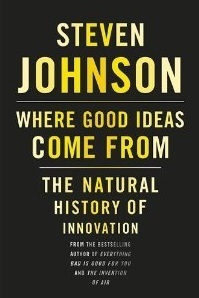 Sometimes life provides happy surprises. I contacted Steven Johnson this summer asking for a blurb for the new edition of The Myths of Innovation – I knew he was a fan of my book from years ago. He provided the blurb, which was great, but the surprise was, after a brief conversation, he asked me to read a late draft of his latest book and give some feedback. An honor indeed, so so I said yes. And this brief review is based on that version.
Sometimes life provides happy surprises. I contacted Steven Johnson this summer asking for a blurb for the new edition of The Myths of Innovation – I knew he was a fan of my book from years ago. He provided the blurb, which was great, but the surprise was, after a brief conversation, he asked me to read a late draft of his latest book and give some feedback. An honor indeed, so so I said yes. And this brief review is based on that version.
I've read dozens of books on innovation, both as...
September 26, 2010
Things to do/eat in Detroit?
I'll be speaking at the Lorenzo cultural center this Wednesday as part of their new exhibit on the history of invention.
It's my first time to Detroit – it's one of the biggest cities in the U.S. I've never been to.
Any recommendations for things to see or food to eat? All I have on my list so far is The Henry Ford Museum.



